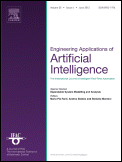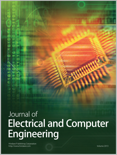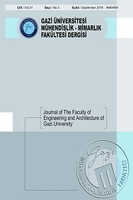
ENGINEERING APPLICATIONS OF ARTIFICIAL INTELLIGENCE
Scope & Guideline
Advancing Engineering Solutions with Intelligent Insights
Introduction
Aims and Scopes
- Artificial Intelligence in Engineering Applications:
The journal focuses on the application of artificial intelligence techniques in various engineering domains including mechanical, electrical, civil, and computer engineering, aiming to demonstrate how AI can optimize processes, enhance product designs, and improve operational efficiency. - Interdisciplinary Collaboration:
The journal promotes interdisciplinary research that combines AI with other fields such as materials science, environmental studies, and biomedical engineering, highlighting the versatility of AI technologies. - Methodological Innovations:
It emphasizes novel methodologies in AI, including but not limited to machine learning, deep learning, neural networks, and fuzzy logic, encouraging the development of new algorithms and frameworks to address complex engineering challenges. - Real-world Problem Solving:
The journal seeks to publish studies that not only advance theoretical knowledge but also provide practical solutions to pressing engineering problems, thus contributing to the enhancement of industry practices and standards. - Sustainability and Efficiency:
A significant focus is placed on the application of AI for sustainable engineering practices, promoting methods that improve energy efficiency, reduce waste, and contribute to sustainable development goals.
Trending and Emerging
- Integration of AI with IoT:
There is an increasing focus on the intersection of artificial intelligence and the Internet of Things (IoT), with research highlighting how AI can enhance data processing, predictive maintenance, and real-time decision-making in IoT systems. - Explainable AI (XAI):
A growing trend towards explainable AI methodologies is evident, as researchers seek to create models that not only perform well but also provide insights into their decision-making processes, crucial for applications in safety-critical systems. - Sustainable AI Solutions:
Research emphasizing sustainability through AI applications is on the rise, with studies exploring how AI can contribute to energy efficiency, waste reduction, and environmentally friendly engineering practices. - AI in Autonomous Systems:
There is a notable increase in research related to AI applications in autonomous systems, including drones and self-driving vehicles, focusing on navigation, control, and safety. - Fusion of Multi-modal Data:
Emerging research trends are showing a preference for methods that integrate multi-modal data sources (e.g., visual, auditory, and sensory data) to improve the robustness and accuracy of AI models in various applications.
Declining or Waning
- Traditional AI Techniques:
There has been a noticeable decline in publications focusing solely on traditional AI techniques such as rule-based systems and expert systems, as the field increasingly embraces more complex and adaptive methodologies like deep learning and reinforcement learning. - Basic Data Preprocessing Methods:
Papers that solely discuss basic data preprocessing techniques have diminished, likely due to the growing sophistication in AI methodologies that integrate preprocessing as part of more comprehensive systems. - Isolated Case Studies:
The journal has moved away from publishing isolated case studies that do not connect to broader trends or frameworks, favoring research that demonstrates broader applicability and integration of AI in various engineering contexts. - Theoretical AI without Practical Application:
There is a waning interest in theoretical discussions around AI that lack clear practical applications, as the field shifts towards research that demonstrates tangible benefits and implementations in real-world engineering scenarios.
Similar Journals

Journal of Zhejiang University-SCIENCE A
Fostering Collaboration and Discovery in Engineering.The Journal of Zhejiang University-SCIENCE A, published by Zhejiang University Press, is a prestigious academic journal dedicated to advancing the field of Engineering since its first issue in 2003. With an ISSN of 1673-565X and E-ISSN of 1862-1775, this journal has established itself as a significant platform for researchers, professionals, and students interested in the multifaceted aspects of engineering science. Located in the heart of Hangzhou, China, the journal has successfully attained a Q2 rating in the 2023 quartiles for Engineering (miscellaneous), showcasing its impact and quality within the discipline, complemented by a commendable Scopus rank of #57 out of 307, placing it in the 81st percentile. Although it does not currently offer Open Access, the journal is committed to disseminating high-quality research findings that foster innovation and collaboration within the engineering community. The journal's scope encompasses a wide range of engineering topics, reflecting the rigorous and evolving nature of the discipline, making it an invaluable resource for advancing academic knowledge and practical applications in engineering.

Tehnicki Vjesnik-Technical Gazette
Advancing Engineering Knowledge for a Global AudienceTehnicki Vjesnik-Technical Gazette is a distinguished open-access journal published by the University of Osijek, Technical Faculty, specializing in the broad field of engineering. With its ISSN 1330-3651 and E-ISSN 1848-6339, the journal has been a platform for disseminating innovative research and technical advancements since its inception in 1994. As part of the Scopus rankings, it holds a respectable position in the Q3 category of Engineering (miscellaneous), specifically ranking #165 out of 307 in the General Engineering field, which places it in the 46th percentile. This journal invites contributions from diverse engineering disciplines and aims to foster collaboration and knowledge sharing amongst researchers, professionals, and students. With its commitment to open access since 2006, Tehnicki Vjesnik ensures that research findings are readily available to a global audience, thereby enhancing visibility and impact. Located in Slavonski Brod, Croatia, this journal serves as a pivotal resource for anyone seeking to stay at the forefront of engineering innovations.

Ingenius-Revista de Ciencia y Tecnologia
Fostering collaboration in diverse engineering disciplines.Ingenius-Revista de Ciencia y Tecnología is a premier academic journal published by the UNIV POLITECNICA SALESIANA ECUADOR, dedicated to the dissemination of high-quality research across various engineering and technological fields. Established in 2011 as an Open Access platform, this journal has fostered knowledge sharing and collaboration among scholars and industry professionals. With a scope that encompasses diverse disciplines including Aerospace, Automotive, Biomedical, Civil, and Computational Engineering, Ingenius serves as a vital resource for researchers aiming to contribute to the advancement of technology and engineering solutions. Although currently placed in the Q4 category across multiple engineering disciplines based on the 2023 rankings, the journal is steadfast in its mission to elevate the quality of published work and enhance its visibility in global research databases. Given its commitment to open access and scholarly dissemination, Ingenius plays a significant role in promoting innovative ideas and fostering educational growth within the engineering community.

PROGRAMMING AND COMPUTER SOFTWARE
Exploring the Frontiers of Software Engineering ExcellencePROGRAMMING AND COMPUTER SOFTWARE is a distinguished journal committed to advancing the field of software development and programming methodologies. Published by PLEIADES PUBLISHING INC, this journal has been a valuable resource since its inception in 1978, reaching out to researchers, professionals, and students alike. With an emphasis on rigorous peer-reviewed articles, the journal holds a Q3 ranking in the realm of Software according to the latest 2023 Category Quartiles. Though it does not offer open access, the journal ensures that high-quality research is disseminated to its audience, providing insights into evolving programming techniques, software engineering challenges, and innovative solutions. With its convergence of years extending to 2024, PROGRAMMING AND COMPUTER SOFTWARE remains a pivotal publication, fostering a deeper understanding of the complexities in computer programming while supporting the broader software community.

Journal of Electrical and Computer Engineering
Pioneering Insights in Electrical and Computer EngineeringJournal of Electrical and Computer Engineering is a premier open-access journal published by HINDAWI LTD, dedicated to advancing the fields of electrical and computer engineering. With an ISSN of 2090-0147 and an E-ISSN of 2090-0155, this journal has been providing a platform for cutting-edge research since its inception in 2007. Based in the United States, it operates from its address at ADAM HOUSE, 3RD FLR, 1 FITZROY SQ, LONDON W1T 5HF, ENGLAND. The journal has established itself with a healthy impact factor, classified in the 2023 Q2 quartile for both Computer Science (Miscellaneous) and Electrical and Electronic Engineering, demonstrating its growing influence in the academic community. Additionally, its ranking positions it within the 67th percentile in General Computer Science and the 61st percentile in Electrical and Electronic Engineering on Scopus, indicating its significant contribution to these fields. Covering an extensive scope from 2010 to 2024, the journal seeks to publish innovative research articles, reviews, and case studies that explore new techniques and applications in electrical and computer engineering, benefiting a wide audience of researchers, professionals, and students focused on these rapidly-evolving areas.

Journal of the Faculty of Engineering and Architecture of Gazi University
Fostering collaboration in the realms of architecture and engineering.The Journal of the Faculty of Engineering and Architecture of Gazi University, ISSN 1300-1884, is an esteemed publication aimed at advancing knowledge in the fields of architecture and engineering. Published by GAZI UNIVERSITY, this journal has established itself as a crucial resource for researchers and practitioners alike since its inception in 1998, with its content spanning up to 2024. Noteworthy for its impact, the journal is categorized in Q2 for Architecture and Q3 for miscellaneous engineering fields, reflecting its significant contribution to ongoing discussions and innovations in these areas. With a Scopus rank of #50 out of 189 in Architecture and #168 out of 307 in General Engineering, this journal resonates with a wide audience by showcasing high-quality research that fosters collaboration and inspiration within the academic community. The journal's commitment to open access facilitates the free dissemination of knowledge, making it an essential read for students, professionals, and researchers looking to contribute to the evolving landscape of engineering and architectural practices. Located in Ankara, Turkey, it serves as a pivotal platform for the international exchange of ideas and methodologies in engineering and architecture.

Revista Iteckne
Exploring New Frontiers in Engineering KnowledgeRevista Iteckne is a prestigious open access journal published by UNIV SANTO TOMAS since 2009, dedicated to advancing knowledge in the fields of technology and engineering. With a focus on innovative research and practical applications, this journal serves as a vital platform for researchers, professionals, and students seeking to share their findings with a global audience. Operating under the ISSN 1692-1798 and E-ISSN 2339-3483, Revista Iteckne facilitates unrestricted access to its content, promoting the dissemination of scientific information. The journal is committed to fostering interdisciplinary collaboration and addressing contemporary challenges in technology and engineering research. By embracing a rigorous peer-review process, it ensures the quality and integrity of published articles, making it an essential resource for those engaged in advancing technological solutions in various sectors. Based in Bogotá, Colombia, the journal plays a significant role in enriching the academic landscape of Latin America and beyond.

Elektrotehniski Vestnik
Illuminating the Path of Electrical Engineering ResearchElektrotehniski Vestnik is a respected journal in the field of Electrical and Electronic Engineering, published by the ELECTROTECHNICAL SOCIETY OF SLOVENIA . With a history dating back to 1969, this journal serves as a platform for disseminating innovative research, technical advances, and practical applications within the electrical engineering domain. Although currently classified in the Q4 quartile according to the 2023 ranking, the journal’s commitment to fostering knowledge within Slovenia and the wider scientific community remains unwavering. The absence of an open access option highlights the journal's traditional publishing model, aimed at ensuring quality and integrity in the peer review process. Researchers, academics, and students interested in exploring emerging trends and foundational topics will find Elektrotehniski Vestnik to be an indispensable resource for both immediate insights and long-term reference in their work and studies.

Journal of Polytechnic-Politeknik Dergisi
Nurturing Ideas that Transform Technology and Education.The Journal of Polytechnic-Politeknik Dergisi, published by GAZI UNIV, stands as a significant platform in the field of engineering and technology, addressing the needs of a diverse audience including researchers, professionals, and students. With an ISSN of 1302-0900 and an E-ISSN of 2147-9429, this journal is committed to disseminating high-quality research that fosters innovation and collaboration in polytechnic education and applied sciences. Located at CENTER CAMPUS TECHNOLOGY FAC B BLOCK EK BINA, 2ND FL, ANKARA 06500, Turkiye, it aims to serve as a vital resource for advancing knowledge and practical applications within the polytechnic community. The journal promotes open discourse on cutting-edge developments and helps bridge the gap between theory and practice. Engaged and comprehensive, it ensures accessibility to pivotal research findings through various academic channels.

Sigma Journal of Engineering and Natural Sciences-Sigma Muhendislik ve Fen Bilimleri Dergisi
Advancing Knowledge in Engineering and Natural SciencesSigma Journal of Engineering and Natural Sciences (Sigma Mühendislik ve Fen Bilimleri Dergisi) is a distinguished open-access journal published by Yıldız Technical University in Turkey since 2004. With an emphasis on the interdisciplinary fields of engineering and natural sciences, this journal caters to researchers, professionals, and students seeking to share innovative research and developments. Although currently positioned in the Q4 quartile across several categories including Computational Mechanics and Mechanics of Materials, Sigma is committed to enhancing its scientific impact and accessibility. The journal invites contributions that enrich knowledge in areas of energy and engineering, addressing complex challenges with a regional and global perspective. Researchers can freely access and disseminate their findings, fostering collaborative advancements in the community. By continually striving for excellence, Sigma Journal serves as a crucial platform for scholarly discourse and innovative research in engineering and natural sciences.